跨文化交际论文题目
- 格式:doc
- 大小:30.00 KB
- 文档页数:2
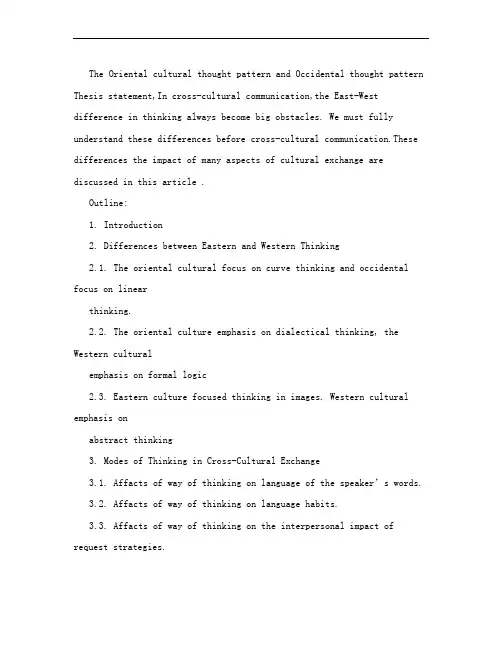
The Oriental cultural thought pattern and Occidental thought pattern Thesis statement,In cross-cultural communication,the East-West difference in thinking always become big obstacles. We must fully understand these differences before cross-cultural communication.These differences the impact of many aspects of cultural exchange are discussed in this article .Outline:1. Introduction2. Differences between Eastern and Western Thinking2.1. The oriental cultural focus on curve thinking and occidental focus on linearthinking.2.2. The oriental culture emphasis on dialectical thinking, the Western culturalemphasis on formal logic2.3. Eastern culture focused thinking in images. Western cultural emphasis onabstract thinking3. Modes of Thinking in Cross-Cultural Exchange3.1. Affacts of way of thinking on language of the speaker’s words.3.2. Affacts of way of thinking on language habits.3.3. Affacts of way of thinking on the interpersonal impact of request strategies.3.4. Affacts of way of thinking on international business negotiations3.5. Affacts of way of thinking on international business contacts4. ConclusionThe Oriental cultural thought pattern and Occidental thought pattern1. IntroductionThinking is a progress that reflects concept,judging,reasoning and other forms of the objective.The way of thinking is that people’s behavior or thought process.It is affected bydifferent cultures, individual knowledge structure, social and work environment and habits. As a social way of thinking, it can be roughly divided into two levels. One is that people’sformation and application of theoretical concepts to grasp an object way of thinking, this is the higher-level one related with people’s university concept, nature andhistory ,having been systematic, theoretical .The other isassociated with daily life experience, the performance of the thinking.2. Differences between Eastern and Western Thinking2.1. The oriental cultural focus on curve thinking and occidental focus on linear thinking.In the expression of ideas, eastern nation accustomed to from the side of the statement of the external st point out the information center. They speak like the subtle roundabout, next to theknock sideswipe. One sum up a word. Because in Chinese culture, language more vague implicit ,more respected. . If the East of Thinking Curve-based approach is similar to a turbine line, then the English-speaking people’sway of thinking is linear, and their thinking is more straightforward, to be used to start with point. They think the problem and speak directly.They will let you know when they think something is wrong,even angry.2.2. The oriental culture emphasis on dialectical thinking, the Western cultural emphasis on formal logicMan and Nature in Chinese culture advocates, advocatingmoderation,it is said "good deed goes unpunished" .As a representative of Eastern culture, Chinese culture emphasizes dialectical thinking. Anchored the Chinese holistic way of thinking, the things as organic whole comprehensive general intuition that each object in terms of ideology to all parts of the joint as overall, his various properties, the links together.The English Culture advocates independence.Theirfaith is “Early bird catches the worm” To theindividual as the basic point of the Western way of thinking, the complexity down into simple element, one by one study, so more emphasis logical analysis, byrationality.Observing things, the nature of law focus on exploring things, pay attention to the form of argument.2.3. Eastern culture focused thinking in images. Western cultural emphasis on abstract thinkingThinking in images is majorily generaledwith a stylizedmanner ,widely using form like the feeling, perception, image and imagination, association and fantasy, and in which mixed into thinkingof those strong feelings and will, characterized by emphasis on visual experience. Representation based on the appearance of the analogous analysis, stressed the similarity, correlation: abstract thought. Dimension is used to summarize the abstract style of thinking and abstract material (concepts, theories,Numbers, reasoning, etc.) thinking. Its features is give a comprehensive analysis of the problem. Giving up Extrinsicattributes, drawn primarily, the nature of the property, emphasizing increased perceptual is rational. The image of the Chinese cultural preference for ways of thinking, and stress forms and management. The Western way of abstract thinking, emphasize conceptual analysis, logical reasoning.3.Modes of Thinking in Cross-Cultural communication3.1. Affacts of way of thinking on language of the speaker’s words.Chinese people are accustomed to thinking in images. In language, Chinese tend to use specific words to express the virtual image of the concept, this expression gives a "real" Ming "," direct "," type ","like "feeling. In the article To make the article clear, vivid, and more use of metaphor, rhetoric, in the words and sentences, especially liketo use images of words, for example, ancient Chinese Fu Xing, by use of image analogy method. is the ancient Chinese literature classics writing style. This has affected the traditional writing techniques. However,for English readers, the flowery language of the general can only reduce transmission clarity and effect, or even be seen as empty verbiage and hype. They are accustomed to a low-key statement. but not used in strong terms. English often use a lot of meaning summary, the alleged general terms to express complex abstract concept of rationality. Thisexpression gives a "virtual", "Pan", "dark", "music", "Hidden "feeling. Chinese people like to use when telling image and analogy. Even if the problems related to preference logic thinking in images. The English nation is like to use the explicit meaning of words to express specific.3.2.Affacts of way of thinking on language habits.Chinese preference for complex thinking, Europe and the UnitedStates preferencefor analytical thinking. Specifically expressed in the language, the Chinese concept of descending expression, English is small to large. For example. When the Chinese write the address order is a state of a province or a city street a building. The opposite order of Europeansand Americans. Chinese way of thinking of the time the order is year, month, day, hour, divided into the sequence, while the Europeans and Americans are just the opposite. This difference in thinking but also in Chinese, fill out your resume written by a distant past, often fromprimary school began to write. Gradually write now, while Europe and the United States who wrote far from near.3.3..Affacts of way of thinking on the interpersonal impact of request strategies.In the traditional Chinese "Heaven", "misplaced" in nature, social values and the curve of thinking, dialectical thinking and harmony under the guidance of people's verbal exchanges with "subtle" and "flexibility" as its characteristic. The language has a strongflexibility and tacit. Han people request more than a "statement of 10 request" mode of communication structure, which first introduced, so as to get each other to understand, sympathize. Then take the opportunity to request. If the other party requests ranging from the speaker said on the active cooperation and help. It is the ideal. This communication strategy can be termed "imply that strategy." Westerners accustomed to ancient Greek logic and language style. They like straightforward. This cultural attitude is reflected in the said request, more than a "request + statement" means of communication structure. The first request, then the situation presented. This communication strategy can be called "direct Chan strategy."3.4. Affacts of way of thinking on international business negotiationsDifferent way of thinking permeates all aspects of business negotiation. To U.S., for example, in the negotiations on the language of choice and use. Americans as a simple, clear and frank manner as soonas possible to explain their views and suggestions. To quickly reach a consensus. The Chinese people are pursuing delaying tactics of rational restraint, avoid direct solution to the problem, the conversation always seems around the problem at hand, puzzled Americans. Order of the negotiations, when faced with a complex De negotiating mandate, the preference selected priority Thinking Ways of Americans often large task into a series of Xiao Fen Jie task. The price, delivery, warranty and service contracts and other issues fractional solution to solve a problem each time, from beginning to end all concessions and commitments, the final agreement is the sum of a series of smaller agreements. However, the overall priority-style way of thinking preferences of the Chinese people would pay attention to the general discussion on all issues did not occur in the order of points, usually to go to negotiations, will be in all of the compromise on the issue and commitment to come to a lot of agreement.3.5.Affacts of way of thinking on international business contactsA typical curve of the Chinese way of thinking makes that they are always first consider the general principles of consensus on the establishment, and then to the specific levels of detail. The Europeans and Americans typically linear way of thinking makes them much attention given to details. General principle is not the slightest consideration. Reflected in specific business methods and practices, the Chinese way of thinking formed the first general retreat, then a pragmatic problem-solving process. That regarding the present, we should first of its guiding principles on the settlementdiscussions to reach consensus, then used to guide the formulationof specific solutions to problems. While Europe and the United States were to take into account every detail, written contracts are usually very long, the contract provides for the parties to the rights, duties and obligations. For them, the contract is a complete, should be observed, legally binding provisions. General principles, or dispensable, or rhetoric, only to solve specific problems can make real progress negotiations5. ConclusionCulture is identitied with the times and national. Way of thinkingis the cultural connotation of a very important aspect. Different times, different ethnic groups who have different way of thinking, even at the same time, the same nation may exist between people of different way of thinking. Therefore, it is worth to emphasize that we compare the differences between the two sides. Does not imply a unique way ofthinking is what nation, while the lack of the national total. Can only say that some of the features in some of the nation in the relative performance of active or prominent in some other nation in therelatively ignored. Taken as a whole. Both traditional Oriental way of thinking, or the Western traditional way of thinking, are the product of historical development, both in the course of human history to maketheir respective contributions. But look at the future development ofmankind, both have their own positive side, also has distinct disadvantages. Ignore the existence of differences, or adhere to this way of thinking to deal with ethnic and cultural exchanges in all the problems is unwise. Similarly, the complete denial of the national wayof thinking, the overall acceptance of foreign cultures and ways of thinking of the approach is also undesirable. With the development of cross-cultural exchange, mutual understanding between Chinese and Western nations are becoming increasingly in-depth. Therefore,integration of two ways of thinking are among the boundaries are increasingly blurred. We should consciously to reduce or narrow the cultural differences, the spirit of "abandoned" the spirit of each other, forming a more scientific, more flexible way of thinking. Thus contributing to more successful nations in the world of mutual understanding and communication, develop more rapidly.跨文化交际英语论文Topic:A comparative study on the Oriental cultural thought pattern and Occidental thought pattern学生赵富强学号 20085800院系建筑城规学院08级建筑系2班。
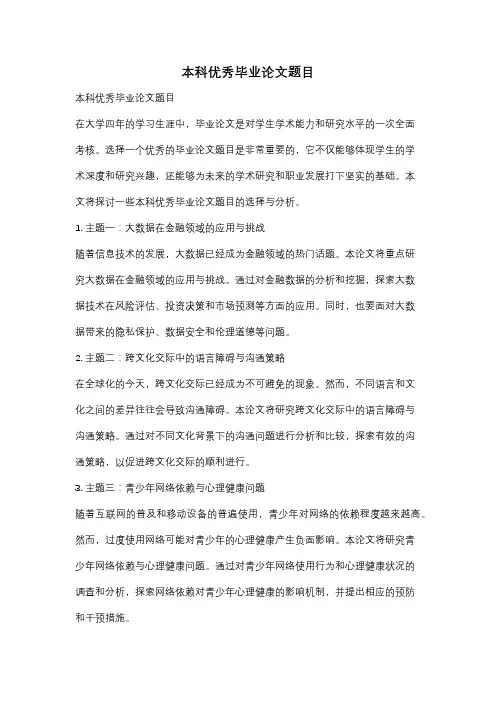
本科优秀毕业论文题目本科优秀毕业论文题目在大学四年的学习生涯中,毕业论文是对学生学术能力和研究水平的一次全面考核。
选择一个优秀的毕业论文题目是非常重要的,它不仅能够体现学生的学术深度和研究兴趣,还能够为未来的学术研究和职业发展打下坚实的基础。
本文将探讨一些本科优秀毕业论文题目的选择与分析。
1. 主题一:大数据在金融领域的应用与挑战随着信息技术的发展,大数据已经成为金融领域的热门话题。
本论文将重点研究大数据在金融领域的应用与挑战。
通过对金融数据的分析和挖掘,探索大数据技术在风险评估、投资决策和市场预测等方面的应用。
同时,也要面对大数据带来的隐私保护、数据安全和伦理道德等问题。
2. 主题二:跨文化交际中的语言障碍与沟通策略在全球化的今天,跨文化交际已经成为不可避免的现象。
然而,不同语言和文化之间的差异往往会导致沟通障碍。
本论文将研究跨文化交际中的语言障碍与沟通策略。
通过对不同文化背景下的沟通问题进行分析和比较,探索有效的沟通策略,以促进跨文化交际的顺利进行。
3. 主题三:青少年网络依赖与心理健康问题随着互联网的普及和移动设备的普遍使用,青少年对网络的依赖程度越来越高。
然而,过度使用网络可能对青少年的心理健康产生负面影响。
本论文将研究青少年网络依赖与心理健康问题。
通过对青少年网络使用行为和心理健康状况的调查和分析,探索网络依赖对青少年心理健康的影响机制,并提出相应的预防和干预措施。
4. 主题四:城市化进程中的环境污染与可持续发展随着城市化进程的加速,环境污染问题日益突出。
本论文将研究城市化进程中的环境污染与可持续发展。
通过对城市环境污染的原因和影响进行分析,探索可持续发展的路径和策略,以实现城市化与环境保护的良性互动。
5. 主题五:人工智能在教育领域的应用与教学改革人工智能技术的快速发展为教育领域带来了新的机遇和挑战。
本论文将研究人工智能在教育领域的应用与教学改革。
通过对人工智能教育工具和平台的分析和评估,探索人工智能技术对教学模式、学生评价和教师角色等方面的影响,以推动教育的创新和发展。

浅析英汉问候语对比及跨文化交际策略探究的论文论文关键词:问候语礼貌原则跨文化交际论文摘要:本文探讨中英问候语中语言和文化差异,并对提高跨文化交际的能力提出相关策略。
问候语是日常会话交际中必不可少的一部分,我们问候别人时,首先考虑的就是礼貌问题。
那么具有不同文化背景的人在互相交际时所赋予这些准则的重要性是否会有差异?因为跨文化交际在很大程度上与交际者对这些准则和策略的恰当选择有关brown和levinson(19871认为,在社会交往中,人们用语言所体现出来的礼貌是有原则的,也是有差异的。
这些原则要求交谈者符合总的礼貌行为;同时,由于人们所处的文化环境不同,对礼貌的衡量和评估标准也不尽相同,而这些不同的衡量标准也会影响交际者在谈话策略上的选择。
为了解释英汉两种不同文化对于礼貌原则选择的差异,以克服跨文化交际障碍,本论文以leech(1983)的礼貌原则和顾日国(1992)的礼貌准则为基础,对英汉问候语进行调查和研究。
一、中英相同的问候语结构、通过考察我们发现,中英文化中的问候活动通常是先开始接触,然后互致某些问候客套,表示欢迎或乐意会面,再作寒暄。
因此,问候语的结构一般包括以下组成部分:招呼、问候、欢迎辞语、表示高兴、寒暄。
但是在许多情况下,随着问候情景的不同,问候活动中许多成分会随时发生变化,某些成分被省略。
一般见面时常用以下问候用语:“go0dmorning(早安)!”、“goodevening(晚安)!”、“howdoyoudo(你好)!”、“howareyou(身体好吗)?”“what’sgoingonwithyourecendy(最近如何)?”、“how’severythinggoing(一切都顺利吗)?”、“longtimenosee.howareyou(好久不见了,你好吗?)”、“iseverythingallifghtiwththechildren(孩子们都好吗)?”、“haveyoubeenonholiday(最近休假去了吗)?”二、中英问候语的礼貌原则对比结合顾日国的礼貌准则与leech关于礼貌的论述对英汉问候语语料进行比较,对问候语的研究结果证明了顾日国的观点——贬己尊人是中国特有的礼貌准则,并且是中国现代礼貌观念的核心。
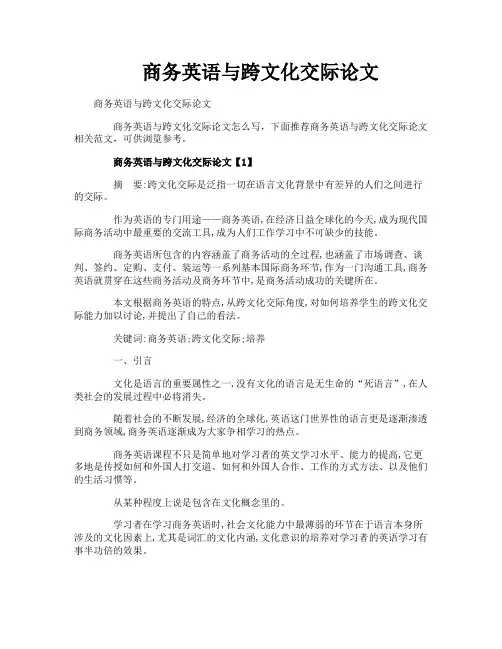
商务英语与跨文化交际论文商务英语与跨文化交际论文商务英语与跨文化交际论文怎么写,下面推荐商务英语与跨文化交际论文相关范文,可供浏览参考。
商务英语与跨文化交际论文【1】摘要:跨文化交际是泛指一切在语言文化背景中有差异的人们之间进行的交际。
作为英语的专门用途——商务英语,在经济日益全球化的今天,成为现代国际商务活动中最重要的交流工具,成为人们工作学习中不可缺少的技能。
商务英语所包含的内容涵盖了商务活动的全过程,也涵盖了市场调查、谈判、签约、定购、支付、装运等一系列基本国际商务环节,作为一门沟通工具,商务英语就贯穿在这些商务活动及商务环节中,是商务活动成功的关键所在。
本文根据商务英语的特点,从跨文化交际角度,对如何培养学生的跨文化交际能力加以讨论,并提出了自己的看法。
关键词:商务英语;跨文化交际;培养一、引言文化是语言的重要属性之一,没有文化的语言是无生命的“死语言”,在人类社会的发展过程中必将消失。
随着社会的不断发展,经济的全球化,英语这门世界性的语言更是逐渐渗透到商务领域,商务英语逐渐成为大家争相学习的热点。
商务英语课程不只是简单地对学习者的英文学习水平、能力的提高,它更多地是传授如何和外国人打交道、如何和外国人合作、工作的方式方法、以及他们的生活习惯等。
从某种程度上说是包含在文化概念里的。
学习者在学习商务英语时,社会文化能力中最薄弱的环节在于语言本身所涉及的文化因素上,尤其是词汇的文化内涵,文化意识的培养对学习者的英语学习有事半功倍的效果。
在对外贸易、国际金融、海外投资、技术引进、招商引资、对外劳务承包与合同等国际商务活动领域,所使用的英语统称为商务英语(Business English),内容涉及到商务活动的方方面面,它是以适应商务领域中的职场生活的语言要求为目的,商务英语作为国际化交往中最重要的交流工具,已经成为人们学习和工作中不可缺少的技能。
商务英语教学的目标,不仅是交给学生“死”的单词、语法、句式等。
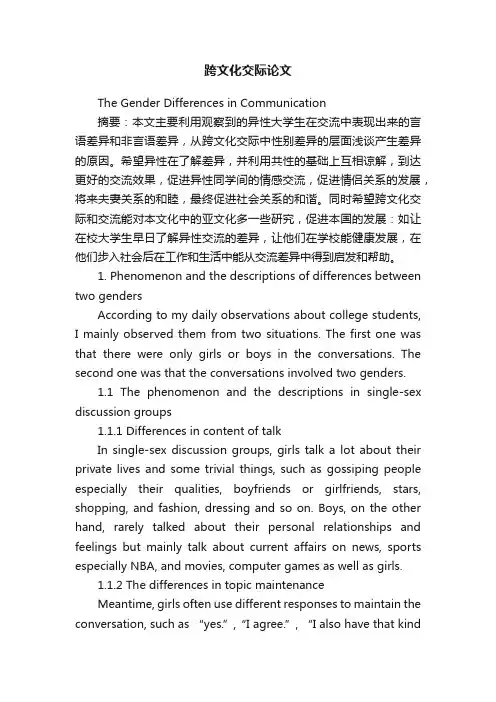
跨文化交际论文The Gender Differences in Communication摘要:本文主要利用观察到的异性大学生在交流中表现出来的言语差异和非言语差异,从跨文化交际中性别差异的层面浅谈产生差异的原因。
希望异性在了解差异,并利用共性的基础上互相谅解,到达更好的交流效果,促进异性同学间的情感交流,促进情侣关系的发展,将来夫妻关系的和睦,最终促进社会关系的和谐。
同时希望跨文化交际和交流能对本文化中的亚文化多一些研究,促进本国的发展:如让在校大学生早日了解异性交流的差异,让他们在学校能健康发展,在他们步入社会后在工作和生活中能从交流差异中得到启发和帮助。
1. Phenomenon and the descriptions of differences between two gendersAccording to my daily observations about college students, I mainly observed them from two situations. The first one was that there were only girls or boys in the conversations. The second one was that the conversations involved two genders.1.1 The phenomenon and the descriptions in single-sex discussion groups1.1.1 Differences in content of talkIn single-sex discussion groups, girls talk a lot about their private lives and some trivial things, such as gossiping people especially their qualities, boyfriends or girlfriends, stars, shopping, and fashion, dressing and so on. Boys, on the other hand, rarely talked about their personal relationships and feelings but mainly talk about current affairs on news, sports especially NBA, and movies, computer games as well as girls.1.1.2 The differences in topic maintenanceMeantime, girls often use different responses to maintain the conversation, such as “yes.”,“I agree.”, “I also have that kindof feeling.” etc. They try to make everyone have a chance to express their feelings. They usually pose some questions related to the topic to show their interests in the topic. So their topic can last for a long time on the basis of corporation. While as for boys, they use less minimal responses and don’t consider others’speaking chances too much; there is a person who talk all the time as others talk less, so their topics shift very quickly. They use more interjections when changing topics such as “Hey!”, “Oh”, “Listen!” et c.1.1.3 The difference in verbal abuseBesides, girls seldom use verbal abuse; their communication is polite, friendly and gently. Their pet phrases don’t relate to verbal abuse. They often use“Oh,dear! ”,“Oh,God! ”,“God bless me! ”and“My God! ”,“Good God! ”,etc. However, boys always speak very rudely to each other, such as “shit!”,“damned!”, and “God damn it!”, “Fuck you!” etc. In fact, those words also have been regarded as pet phrases and don’t think they are not suitable to use.1.2 The phenomenon and the descriptions in mixed-sex discussion groups1.2.1 The differences in interpretationsWhen girls and boys talk together, girls often first put forward a topic, but during theirconversation, if a boy doesn’t a girl’s view, he will interpret the girl’ ta lk directly and then express his opinions all the time. They even ignore what girls have said or the questions that girls have raised. Therefore, their talk takes on a feature of reasoning or lecturing others. But the girls will not do like that. Generally speaking, girls like to indirectly and euphemistically express their opinions. They always give consideration to the face and dignityof others.1.2.2 The differences in postures and personal spaceLast but no least, there is also some differences between boys and girls in their body language when they are talking together. Girls take up less physical space, sitting with arms and legs toward their body. They also assume more forward positions when sitting and lean forward while listening. During conversation, they will not approach boys as closely in terms of their personal space. They have greater sensitivity and acuity toward other people's nonverbal communication cues. By contrast, boys are totally different. They not only take up more physical space when sitting or standing, with arms and legs stretched out away from their body, but tend to approach women more closely. They assume more reclined positions when sitting and lean backward when listening. Furthermore, they are not as sensitive to the communication cues of others as girls.2. Analysis from the aspect of intercultural communication2.1 Analysis from the Ways in which Children Grow upAccording to Ronald Wardhaugh, "men's and women's speech differ because boys and girls are brought up differently". As children, women are encouraged to be "little ladies". “High spirits" are expected and therefore tolerated in little boys; docility and resignation are the corresponding traits expected of little girls. Also, there are competing pressures on children from their peers. Boys, in particular, feel they have to talk rough with other boys in order not to be ridiculed. While girls are under the same pressure to fit in with a group, they have to be careful not to go too far or people will judge them negatively. Looking at adults, we can see that speech differences between men and women are actually continuity of children's ways of speaking and themanagement of conversation.2.2 Analysis from women and men’s different status and roles in societyThe reasons why women and men choose different topics in communications are various. It not only relates to their work but the traditional stereotypes. In history, generally speaking, women played the roles of housewives and men had their jobs. Men had the right to receive education and participate in politics. They could make contact with different people and travel in different places. While women are opposite, they had to stay at home from childhood and after they get married, their work was just to babysit, do housework, and take care of their husbands. They had no equal status and rights with men. So their horizons are limited and knowledge is far less than men. Women’s talking contents are about family, children and personal life. But men can talk about economy, politics, and business and travel. Therefore, the phenomenon that women’s topics are narrow but men’s are wide can be derived from primitive society. Furthermore, these historical and traditional reasons deeply affect women’s status and roles in current society. Except for thosereasons, women’s physiological features also lead to their own division of labor in society; especially women’s physical strength can not be compared with men’s.Because of the stereotypes: Men are breadwinners and women are homemakers; men are bold and unstrained, brave and independent as well as generous when talking. While women should have polite manners and they pay more attention to details. So men’s rudeness, competition and directness can show they are strong, independent and macho. In contrast, if a woman behaves as the way of men, others will think she is notelegant and graceful, because it d oesn’t match her identity or a women’s standard. So women’s every word and every action not only are paid attention by themselves but other people. They have to keep one eye on their own speech and gestures.2.3 Analysis from individualism and collectivism, masculinity and femininityIndividualism and collectivism mainly emphasize how individuals view themselves and their linkage. In single-sex communications, women and men both show their collectivism because of their communicating goal all include sharing information. So when they talk about their interested topics, they will consider others’speech turns. However, women have a more strong sense of collectivism than men because women’s strategies that are made use of in communications show they are more polite, considerate and corporative than men. Although women and men all share information, in all men conversations, men are more likely to use verbal abuse and one of them tend to dominate the conversation. Even if there are women to participate in the conversation, men still interpret women’s speech directly and even ignore what women have said. They just try to express their opinion all th e time and don’t consider women’s dignity or face at all. On the contrary, women are always considerate and their communicating goal not only include sharing information but some other aims, such as asking for advices, exchanging opinions, and amusing each other, etc. So women’s communicating behaviors are equal to each other. What’s more, women and men stand for different characteristics. Masculinity is shown by men. Competitiveness, assertiveness and aggressiveness are main masculine traits. So men like to talk about aggressive contents and there are alwayscompetitive to tell others they are better formed about sports, news and travels. By contrast, women show femininity, such as cooperation, nurturing and gentility. So their words are not so harsh and sharp. There are no rude words and respect everyone’s speech right. Under this condition, women’s conversation often can last for a long time.2.4 Analysis from the nonverbal communications and personal spaceIn communications, women and men all use nonverbal communications, especially body language. Body language is a form of mental and physical ability of human non-verbal communication, consisting of body posture, gestures, facial expressions, and eye movements. Humans send and interpret such signals almost entirely subconsciously. After women and men use some body posture and gestures by the same body parts, such as legs and arms, the effect on each other are totally opposite. Women’s personal space is taken up and invaded by men. Taking this phenomenon as example, when sitting or standing, boys always stretched their arms and legs out away from their body, and they tend to approach girls more closely. Generally speaking, women’s personal space is obvious smaller than men’s. Not only in public, like on the s treet, but in private place, like office room, is the same case——wome n’s personal space is invaded while men will be more sensitive and active to keep their personal space away from invading(). This different space relation that is resulted from different gender has already appeared in people’s childhoods. Little girls usually are only allowed to play indoors but boys are encouraged to play outdoors. Many researchers found that people are more unwilling to get close to women. However, women tend to beobed ient to this invasion and when invasion happens, they’d like to move a little away or give up the place directly because men are usually regarded as a threat. In this case, such cultural image gives men more rights to their own space. Therefore, boys often take up more space and tend to move close to girls.3. What I have learned and suggestions to intercultural communicationCommunications can reflect culture and culture also can influence communications. The differences between different genders in communications clearly show the differences between two different subculture that are separately represented by women and men. Because these two different subcultures have their own traits, those traits often cause some unnecessary misunderstandings. In college, boys and girls seems don’t know too much about each other. So there are a lot of young couples who cannot stand the opposite and finally break up. Once they break up, it is easy to leave a bad impression on each other’s mind. In fact, in most cases, the reason why they break up is that there are too many misunderstandings in communications. Girl don’t know boy’s taking style, boys cannot understand girls’behaviors, either. Therefore, the earlier they know each other, the better they will communicate. I hope intercultural communication can study more small aspect about subcultures. The scoop of intercultural communication’s study is generally too wide because it always researches on different cultures in different countries. If it can study more detailed things, it will benefit a lot of common people, such as young couples. Finally, I believe it will make people’s families happy, and their interpersonal relationship will develop more successful; this society will become more harmonious.References:Wardhaugh, Ronald. An Introduction to Sociolinguistics [M]. Blackwell Publishers Ltd, 1998.陈雪飞. 跨文化交流论[M]. 实事出版社, 2012: 255关世杰. 跨文化交流学:提高涉外交流能力的学问[M]. 北京大学出版社,1995. 311~312刘莹. 2009 科技信息[J]. 浅析性别差异在语言中的体现及其原因255张琳琳. 2011 海外英语[M] 语言的性别差异及成因320。
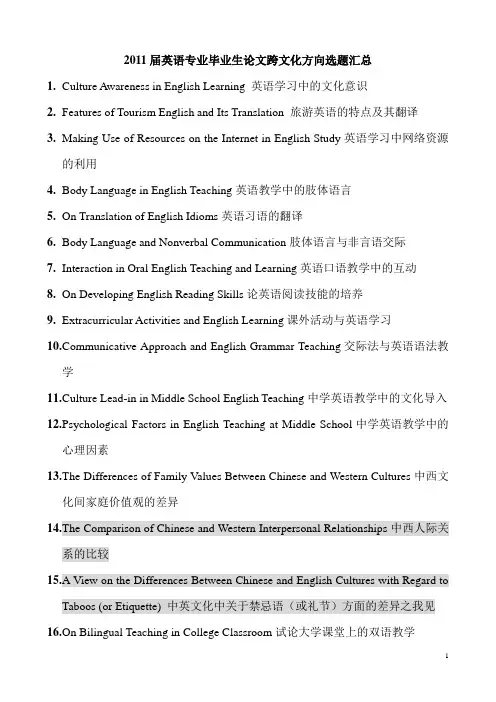
2011届英语专业毕业生论文跨文化方向选题汇总1.Culture Awareness in English Learning英语学习中的文化意识2.Features of Tourism English and Its Translation旅游英语的特点及其翻译3.Making Use of Resources on the Internet in English Study英语学习中网络资源的利用4.Body Language in English Teaching英语教学中的肢体语言5.On Translation of English Idioms英语习语的翻译6.Body Language and Nonverbal Communication肢体语言与非言语交际7.Interaction in Oral English Teaching and Learning英语口语教学中的互动8.On Developing English Reading Skills论英语阅读技能的培养9.Extracurricular Activities and English Learning课外活动与英语学习10.C ommunicative Approach and English Grammar Teaching交际法与英语语法教学11.C ulture Lead-in in Middle School English Teaching中学英语教学中的文化导入12.P sychological Factors in English Teaching at Middle School中学英语教学中的心理因素13.T he Differences of Family Values Between Chinese and Western Cultures中西文化间家庭价值观的差异14.T he Comparison of Chinese and Western Interpersonal Relationships中西人际关系的比较15.A View on the Differences Between Chinese and English Cultures with Regard toTaboos (or Etiquette)中英文化中关于禁忌语(或礼节)方面的差异之我见16.O n Bilingual Teaching in College Classroom试论大学课堂上的双语教学17.A Survey on Students’ Motivation of English Learning学生英语学习动机的调查报告18.C omparison of Euphemism in Wording of Sino-Western letters中西书信用语的委婉语比较19.中英电视广告中的非言语文化对比A Comparison of the Nonverbal Languagein English and Chinese Television Advertisement20.中英平面广告中的非言语文化对比A Comparison of the Nonverbal Languagein English and Chinese Print Advertisement21.非言语交际在中英商务谈判中的体现The Application of Nonverbal Languagein Sino-U.S. Business Negotiation22.中美价值观对商务谈判方式的影响The Influence of Different Values onSino-U.S. Business Negotiation23.浅析中英问候语的差异A Study on the Difference of Greeting Words in Englishand Chinese24.英文服饰广告在中国全球本土化可行性研究Feasibility of Glocalizing EnglishClothing and Accessories Advertisement in China25.英文奢侈品广告在中国全球本土化可行性研究Feasibility of GlocalizingEnglish Luxury Goods Advertisement in China26.英文化妆品广告在中国全球本土化可行性研究Feasibility of GlocalizingEnglish Cosmetics Advertisement in China27.从情景喜剧看中西青少年价值观的异同之处A Study on the Similarities andDifferences between Western and Chinese Teenagers from Sitcoms28.英文情景喜剧中幽默方式研究A Study on the Humor Style in English Sitcom29.从英文综艺节目看美国人的价值观A Study on the American Values in EnglishVariety Shows30.中英成语中的不同动物形象研究Similarities and differences in the CulturalConnotation of Animal Words in English and Chinese Idioms31.中英习语中的数字文化对比研究Similarities and Differences in the CulturalConnotation of Numbers in English and Chinese Idioms32.浅谈思维定势对英语学习的影响The Impact of Stereotype on English Learning33.中国学生在英语课堂上的小组活动的表现研究A Study on the Group WorkPerformance of Chinese Student in English class34.浅谈如何在英语课堂上提高中国学生的跨文化交际能力The Improvement ofChinese S tudents’ Cross-Cultural Communication Ability in English Class35.全球化背景下对中国大学生价值观取向的探讨The Value Orientation ofChinese College Student Under the Circumstances of Globalization36.从饮食文化看中西价值观的异同之处Similarities and Differences in theCultural Connotation of English and Chinese Food Culture37.从中国食物的英译看中国文化对英语国家的影响The Influence of ChineseCulture on English-speaking Countries from the Translation of Chinese Food38.文化差异与英语写作Cultural Difference and English Writing39.英语习语中的人名浅探Tentative analysis on names from English Idioms40.汉英回应赞美语策略差异及原因分析An Analysis on the Different ResponsiveStrategies Used by the Chinese and Westerners and the Reasons Concerned41.从文化差异看合作原则与礼貌原则On Cooperative Principle and PolitenessPrinciple on the Basis of Cultural Difference42.称赞语及其应答语的跨文化对比研究Contrastive Cross-Cultural Study ofCompliments and Compliment Responses43.谈跨文化交际中的文化现象Cultural Phenomena in Inter-cultureCommunications44.中西体态语差异的文化透析An analysis on body language conflict betweenChina and Western countries45.跨文化商务沟通中身势语的文化解读On Body Language in InterculturalBusiness Communication from a Cultural Perspective46.跨文化交际的有效策略Effective strategies for intercultural communication47.跨文化交际障碍产生的主要原因及对策On the Cause of InterculturalCommunicative Obstacles and Counter Measures48.跨文化交际中的中美价值观比较——小议集体主义与个人主义Comparison of Values between China and American in Cross-cultural Communication: Discussion on Collectivism and Individualism49.中英婚俗文化及差异Comparative Study of the Marriage Custom Differencebetween Chinese and British Culture50.身份和跨文化交际Identity in Cross-cultural Communication51.口译与跨文化意识Cross-cultural Awareness in Interpretation52.中西节日文化之比较The Comparison of Festival Cultures between China andWestern Countries53.论李安电影的中西文化认同On the Cultural Identity between Chinese andWestern in Ang Lee’s movies54.A Study on Culture Inputs in Integrated English Class 综合英语课堂上文化信息植入研究55.A Study on Culture Input in Listening Class for English Majors英语专业听力课上文化信息植入研究56.T he Fostering of Intercultural Awareness in Integrated English Class 综合英语教学中跨文化意识的培养57.T he Fostering of Intercultural Awareness in Oral Class for English Majors英语专业口语教学中跨文化意识的培养58.A n Analysis on the Presentation and Usage of Culture-related Information inIntegrated English Textbooks 综合英语课本文化信息表现方式与使用探讨59.A n Analysis on the Presentation and Usage of Culture-related Information inBusiness Textbooks商业类型课本文化信息表现方式与使用探讨60.A n Analysis on the Opening Paragraph of English Compositions Written byChinese Students 中国学生英语作文开篇手段分析61.A n Analysis on the Concluding Paragraph of English Compositions Written byChinese Students中国学生英语作文结尾手段分析62.A n Analysis on the Cultural Value Orientation Concerning Textbooks for EnglishMajors 英语专业课程教材中的文化价值取向63.A n Analysis on the Cultural Value Orientation Concerning TEM8 ReadingComprehension 英语专业八级考试中阅读理解题目的文化价值取向64.A n Exploration on English Majors Interpretation of Culture Presentation inEnglish Poems 英语专业学生对英语诗歌文化表象的解读探讨65.A n Exploration on English Majors Interpretation of Culture Presentation inEnglish Texts英语专业学生对英语课文中文化表象的解读探讨66.T he Comparison between the Reporting Strategies in Chinese Media and EnglishMedia中西新闻报道策略的比较67.T he Comparison on the Diction in Chinese News Repots and English NewsReport---A Case Study中英新闻中措词方式的个案研究68.T he Comparison on the Diction in Chinese News Headlines and EnglishHeadlines中英新闻中标题措词方式的研究69.A Discussion on the Presentation and Function of Chinese Elements in HollyFilms 好莱坞电影中的中国元素呈现与功能探讨70.A Discussion on the Presentation and Function of Chinese Characters in AmericanMovies 美国电影中的中国角色的呈现与功能探讨71.论中美日商务谈判中的跨文化交际因素A Study on the Intercultural FactorsAmong Chinese, American and Japanese Negotiation72.论跨文化广告翻译On Cross-cultural communication on AdvertisementTranslation73.从跨文化角度看中西广告特征及翻译Features and Translation of Western andChinese Ads from the Perspective of Cross-cultural Theory74.中英商务信函格式对比A comparative study on the format of Chinese andEnglish business letters75.中美广告的价值观对比A comparison on Ads between China and America values76.从《刮痧》看中西价值观差异On the Difference between Chinese and WesternValues in Guasha77.从《刮痧》看中西文化中的孝顺On the Cultural Difference about Filial Piety inGuasha78.论身势语在跨国企业的语用功能On the Pragmatic Function of Body Languagein Multinational Companies79.空间语言在商务谈判中的应用On the Application of Spatial Language inBusiness Negotiation80.英汉文化差异与误译Chinese and English Cultural Difference and Mistranslation81.英汉数字“一”的文化对比与翻译The Comparison and Translation of “One” inChinese and Western Culture82.中英文化差异对国际商务礼仪的影响The Influences of Chinese-BritishCultural Differences on International Business Protocol83.从集体主义和个人主义看国际商务谈判的文化差异Cultural Differences inInternational Business Negotiations: from the perspective of Collectivism and Individualism84.国际商务交流的文化障碍Cultural Barriers in International BusinessCommunication85.商务沟通中的文化休克现象:问题与对策Cultural Shock in BusinessCommunications and Its Countermeasures86.汉英称谓语中的文化差异Cultural Differences in Chinese and EnglishAddress Forms87.从跨文化角度谈汉英思维及表达方式的差异 A Cross-cultural Study onThinking Patterns and Expressing Modes of Chinese and English88.跨文化交际中英汉礼貌与面子 A Study On Politeness and “Face”inCross-cultural Communications89.商务信函中委婉语的跨文化研究 A Cross-cultural Study of Euphemisms inEnglish and Chinese Business Correspondence90.商务沟通中非言语交际的跨文化研究 A Cross-cultural Study of NonverbalCommunication in Business Context91.从广告用语看中西文化价值观的差异Chinese and Western Culture Values inAdvertising Language92.中美商务谈判中的文化冲突现象与应对策略Cultural Conflicts in Sino-U.S.Business Negotiation and Countermeasures93.英汉姓名的跨文化研究A Cross-cultural Study of English and Chinese Names94.中美商务谈判中的时空观的差异分析A Cross-cultural Study on Views of Timeand Space in Sino-U.S. Business Negotiations95.中西广告文化内涵比较分析A Comparison of Cultural Connotations in Chineseand English Advertisements96.从中英谚语看中西方的文化差异On Chinese and English Proverbs: from aCross-cultural Perspective。
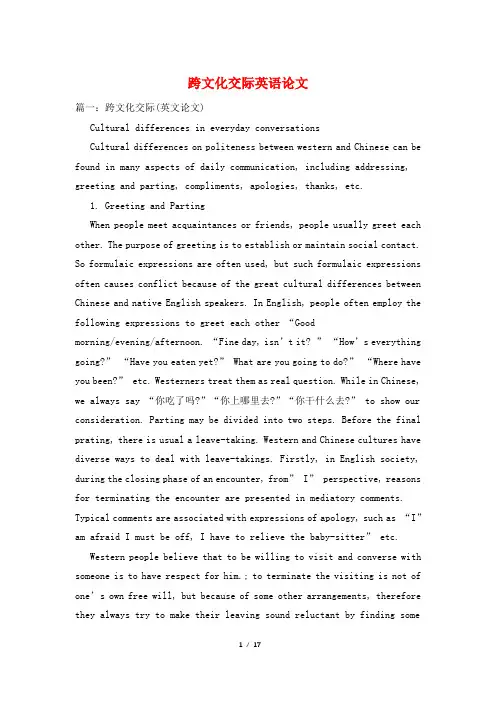
跨文化交际英语论文篇一:跨文化交际(英文论文)Cultural differences in everyday conversationsCultural differences on politeness between western and Chinese can be found in many aspects of daily communication, including addressing, greeting and parting, compliments, apologies, thanks, etc.1. Greeting and PartingWhen people meet acquaintances or friends, people usually greet each other. The purpose of greeting is to establish or maintain social contact. So formulaic expressions are often used, but such formulaic expressions often causes conflict because of the great cultural differences between Chinese and native English speakers. In English, people often employ the following expressions to greet each other “Goodmorning/evening/afternoon. “Fine day, isn’t it? ”“How’s everything going?”“Have you eaten yet?” What are you going to do?”“Where have you been?” etc. Westerners treat them as real question. While in Chinese, we always say “你吃了吗?”“你上哪里去?”“你干什么去?” to show our consideration. Parting may be divided into two steps. Before the final prating, there is usual a leave-taking. Western and Chinese cultures have diverse ways to deal with leave-takings. Firstly, in English society, during the closing phase of an encounter, from” I” perspective, reasons for terminating the encounter are presented in mediatory comments. Typical comments are associated with expressions of apology, such as “I”am afraid I must be off, I have to relieve the baby-sitter” etc.Western people believe that to be willing to visit and converse with someone is to have respect for him.; to terminate the visiting is not of one’s own free will, but because of some other arrangements, therefore they always try to make their leaving sound reluctant by finding somereasons and apologize for it to make the leaving acceptable for both parties. English speakers often signal several times before leaving. “Well, it’s been nice to see you again. I do enjoy our talk and the lovely dinner, but I must be going soon”. Thank you very much for asking me over.I hope we’ll be able to get together again before long…” Consolidation in a wider range of common acquaintances also occurs, in expressions such as “Say hello to Jack for me” or “Remember me to John”. In Chinese society, during the closing phase of and encounter, usually, from a “you”perspective, reasons for ending the encounter are set forth in mediatory expressions. Such expressions include“你挺忙的,我就不多打扰了。
![[英语跨文化论文选题]英语专业论文选题](https://uimg.taocdn.com/5ea8641bc4da50e2524de518964bcf84b8d52d52.webp)
[英语跨文化论文选题]英语专业论文选题英语跨文化论文选题(一)1.英文原声电影赏析与跨文化交际能力的培养2.跨文化非语言交际语用失误研究3.公示语翻译中的语用失误探析4.国内广告语言语用失误研究现状与分析5.全球化语境下跨文化交际失误语用归因6.跨文化交际中的语用失误类型及对策研究7.基于礼貌原则的跨文化语用失误分析8.跨文化言语交际中的语用负迁移9.浅析化妆品广告中的语用预设10.中西方饮食文化的比较研究11.中美时间观之对比12.浅析汉英问候语中的文化差异13.英汉词汇的文化内涵差异探析14.英语身体语的交际功能研究15.浅谈英汉身势语的表意功能之差异16.目标语文化的理解与跨文化交际17.中西文化差异对中国学生英语学生的影响18.跨文化交际中的文化误读19.浅析文化差异对商务谈判的影响20.英语禁忌语的文化内涵异同研究英语跨文化论文选题(二)1.英汉思维模式的差异对跨文化交际的影响2.外语学习者的思辨能力与跨文化交际之成效3.培养英语学习者跨文化交际能力之策略4.英汉道歉语差异及原因5.中西跨文化礼貌语差异探析6.英汉语言中礼貌表达法之比较7.英汉习惯用语的文化内涵探源8.英语称赞语及其回应的异同研究9.中美(西)家庭教育理念的差异及其对孩子的影响10.中国英语学习者跨文化交际中的主要障碍研究11.试析跨文化交际中角色互动的作用12.本土文化与异国文化的冲突对跨文化交际的影响13.跨文化交际中的时间观差异14.论跨文化交际中的中西餐桌礼仪15.关于提升英语专业学生跨文化交际能力的培养16.涉外婚姻中的中西文化冲突17.论跨文化广告传播中食品商标的翻译18.多媒体教学与跨文化交际能力的培养19.中西方儿童文学的差异20.中西体育文化的差异及其受全球化发展的影响21.中西传统休闲文化及其价值观的对比分析22.简爱与林黛玉不同命运的文化透析23.国际商务活动中礼貌原则的应用英语跨文化论文选题(三)1.从中英文动物比喻的不同看中西文化差异2.英汉概念隐喻的文化认知对比分析3.英汉成语文化内涵比较研究4.从神话看中西文化异同5.文化视角下英汉时间隐喻比较研究6.英汉情感隐喻文化内涵对比研究7.从文化语境看英汉爱情隐喻8.英汉动物隐喻的文化内涵9.论中英文中颜色隐喻的差异及其文化根源10.英汉习语中中西文化差异探源11.从英汉委婉语中看中西文化心理差异12.文化视阈中的汉英典故13.美国俚语的基本特征与社会功能14.从旅游广告看中西文化差异15.英语学习中中国文化缺失对跨文化交际能力的影响16.正视中西文化冲突提高跨文化交际能力17.从跨文化交际中的语用负迁移反思英语教学18.情境教学法在跨文化交际教学中的应用19.从跨文化交际的角度解读中西方礼貌准则和策略20.英汉委婉语及其在跨文化交际中的21.英语教学中学生跨文化交际能力的培养22.跨文化交际中的饮食文化差异23.从集体主义和个人主义看国际商务谈判的文化差异24.中英礼貌用语之差异25.过渡语僵化现象文化因素成因26.跨文化交际中的美国个人主义27.英汉隐喻的文化背景差异研究28.中英礼貌用语研究综述29.颜色词的文化内涵30.中国茶文化与西方咖啡文化对比研究31.汉英称谓语中的文化差异32.民俗风情游--中西“水”文化之比较33.跨文化商务谈判中的文化适应34.跨文化交际中的空间观35.英汉习语的文化差异分析36.当代中美女性婚姻观的比较研究37.中美商务谈判礼仪之礼貌用语比较。
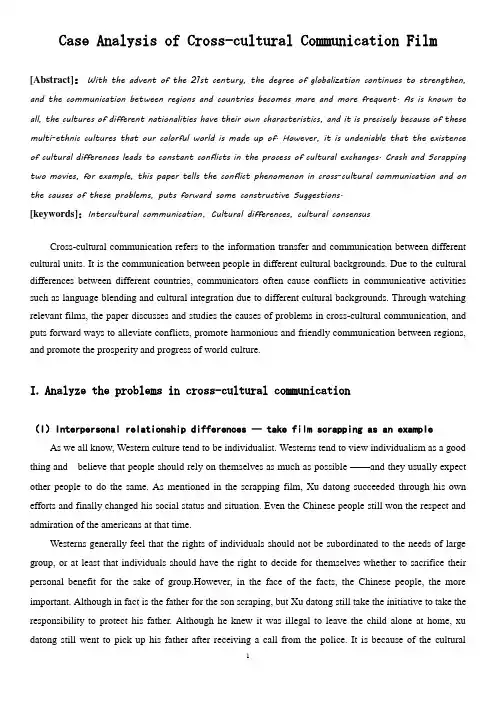
Case Analysis of Cross-cultural Communication Film [Abstract]:With the advent of the 21st century, the degree of globalization continues to strengthen,and the communication between regions and countries becomes more and more frequent. As is known to all, the cultures of different nationalities have their own characteristics, and it is precisely because of these multi-ethnic cultures that our colorful world is made up of. However, it is undeniable that the existence of cultural differences leads to constant conflicts in the process of cultural exchanges. Crash and Scrapping two movies, for example, this paper tells the conflict phenomenon in cross-cultural communication and on the causes of these problems, puts forward some constructive Suggestions.[keywords]:Intercultural communication,Cultural differences, cultural consensusCross-cultural communication refers to the information transfer and communication between different cultural units. It is the communication between people in different cultural backgrounds. Due to the cultural differences between different countries, communicators often cause conflicts in communicative activities such as language blending and cultural integration due to different cultural backgrounds. Through watching relevant films, the paper discusses and studies the causes of problems in cross-cultural communication, and puts forward ways to alleviate conflicts, promote harmonious and friendly communication between regions, and promote the prosperity and progress of world culture.I.Analyze the problems in cross-cultural communication(I)Interpersonal relationship differences -- take film scrapping as an example As we all know, Western culture tend to be individualist. Westerns tend to view individualism as a good thing and believe that people should rely on themselves as much as possible ——and they usually expect other people to do the same. As mentioned in the scrapping film, Xu datong succeeded through his own efforts and finally changed his social status and situation. Even the Chinese people still won the respect and admiration of the americans at that time.Westerns generally feel that the rights of individuals should not be subordinated to the needs of large group, or at least that individuals should have the right to decide for themselves whether to sacrifice their personal benefit for the sake of group.However, in the face of the facts, the Chinese people, the more important. Although in fact is the father for the son scraping, but Xu datong still take the initiative to take the responsibility to protect his father. Although he knew it was illegal to leave the child alone at home, xu datong still went to pick up his father after receiving a call from the police. It is because of the culturaldifferences between the two sides that led to the tragedy of the life of Xu datong's family.Westerns tend to believe that individuals should make decisions for themselves, and that individual should take credit and responsibility for what they have personally done.In the film, a colleague of Xu datong, instead of helping him escape unwarranted charges under the law, testifies in court that he abused his son. One of the important reasons why this happened is that americans advocate individualism, law and facts, and colleagues do not know about scrapping and saw Xu datong beat his son, which led to the tragedy in the movie.(II)Conflicts caused by cultural differences -- take movie Crash as an example Does a white farmer in Illinois have so much in common with a black banker in New York that what we say they all belong to the same culture?Obviously there will be many difference between these two people ——they live in different regions, have different jobs, have different ethnic background, and so forth .Throughout the movie, I'm impressed with the two black brother, came out from the coffee shop, one of the black has been complaining about discrimination against blacks, whites and another black didn't think so, but in the black complain, another black gradually produced a strong sense of identity, so they conducted armed robbery, hit-and-run, and so on a series of bad things.In fact, this story can reflect the parents' teaching to their children, whether white or black, if parents teach them from an early age that white is noble, will not swear, will not do wrong, black is rude, uncivilized, always doing wrong. Then the idea will be rooted in the idea of children, then white and black children can never be friends, the misunderstanding between white and black people will be deeper, the conflict between the two sides will become more and more fierce, I believe if things go on for a long time, will eventually lead to the inevitable riots.However, most likely there are many things that they share in common. For example, the schools they went to probably taught roughly the same kinds of courses, they probably watch many of the same TV programs, they live under the same government and legal system ,and they probably all speak the same language.As a result, even if these people look different on the outside, the ideas and information in their heads will have much in common. You should say that they are many different brands of computers that look different on the outside, but have a lot of the same software and data. It is these shared ideas that make a grou p of people into a culture , in fact, you should say that a “culture ”is essentially a group of people who carry many of the same ideas in their heads.Most modern societies believe that equality is a virtue.But there's no denying that every society still has hierarchy to some degree. In other words, some people have higher and more power than others. Thisinjustice is mainly reflected in the racial discrimination in the United States. In the movies, white people always have a higher status than black people, and black people are not respected by white people.Preserving good relationship and harmony between people, especially among one's ingroup and circle of acquaintance, is generally considered very important. so people generally try to avoid direct confilt. Therefore, in order to avoid conflicts, every one of us should master certain methods when conducting cross-cultural communication, so as to consciously carry out correct cross-cultural communication and promote the formation of a beautiful and harmonious society.II solutions to cross-cultural communication problems(I)Strengthen cross-cultural communication and learn from western culture Peace and good relation between nations, people and cultures need to be beased on mutual understanding. As you study English, you are learning how to be an ambassador who can serve as a bridge between China and the world, a translator who can help people of China and other countries better understand each other. The more you understand about intercultural communication, the more effectively you can serve as an ambassador for your own culture and as a bridge between your culture and others.When you are new to Chinese culture, this made it harder for you to understand why the other people acted as they did. When you really didn't understand what was happening, you should consider other possible explanations for the Chinese students' behavior instead of jumping to negative conclusions. To communicating with local people, you 'd better to improve the local language and learn as much as possible about local culture. Of course, you also need to learn something about intercultural communication and learned how to be a more effective intercultural communicator.As you learn about other culture there are two good habit you should cultivate right from the start. First, build the habit of consciously making an effort to avoid stereotypes. second, build the habit of making a conscious effort not to judge other cultures too quickly. one of the best way to manage our tendency to judge negatively is by cultivating the habit of describing things instead of evaluating them.(II)Interpreting what foreigners mean“Interpretation ”the process of deciding what foreigners' words and action mean and why they do what they do. However when you interpret the behavior of foreigners, you don't have so much cultural background information to help you understand their behavior, so you have to guess and use your imagination much more. If you interpret their behavior quickly, without thinking carefully and getting asmuch information as possible, it is very likely that your Interpretation will be at least partially wrong.The same three habits will help you be a more effective intercultural communication. First, get into the habit of consciously noticing that you are entering an intercultural encounter. Second, get into the habit of interpreting intercultural encounters more slowly, rather than jumping to conclusion quickly. The last but not least, get into the habit of thinking more consciously and carefully about the situation.(III)To become a good intercultural communicatorThere is no doubt that you will probably have to speak in English when you are interacting with Westerners .In fact, when people from two different cultures try to communicate with each other, at least one of them will almost certainly have to speak in some language other than his native tongue. Therefore to avoid the language gap problem and become a good intercultural communicator, you need to be aware of how speaking in a foreign language affect you and make a special effort not to let these negative affect how you interpret the words and actions of others.III.The conclusionAs I talk about culture in this passage, my goal is not to say that one culture is better or worse than another. Instead, our goal is to describe differences between culture,and try to come to a better understanding of Western and Chinese culture. Before one can evaluate a culture, one must understand it.Reference:I: A Book called Encounters With WesternersII: A Film called CrashIII: A Film called Scrapping。
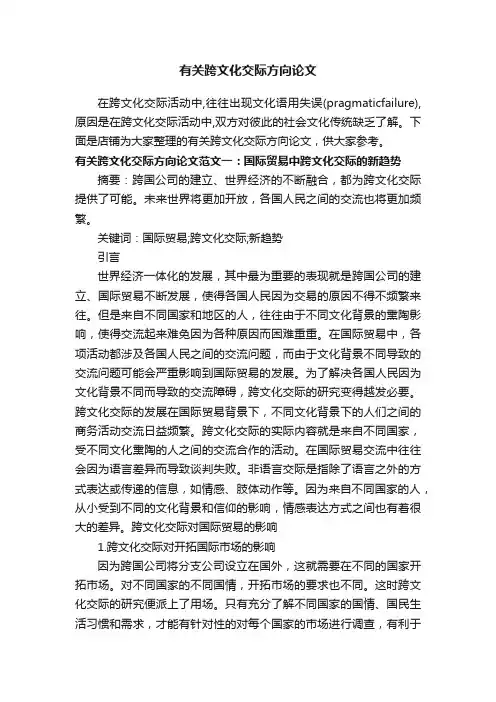
有关跨文化交际方向论文在跨文化交际活动中,往往出现文化语用失误(pragmaticfailure),原因是在跨文化交际活动中,双方对彼此的社会文化传统缺乏了解。
下面是店铺为大家整理的有关跨文化交际方向论文,供大家参考。
有关跨文化交际方向论文范文一:国际贸易中跨文化交际的新趋势摘要:跨国公司的建立、世界经济的不断融合,都为跨文化交际提供了可能。
未来世界将更加开放,各国人民之间的交流也将更加频繁。
关键词:国际贸易;跨文化交际;新趋势引言世界经济一体化的发展,其中最为重要的表现就是跨国公司的建立、国际贸易不断发展,使得各国人民因为交易的原因不得不频繁来往。
但是来自不同国家和地区的人,往往由于不同文化背景的熏陶影响,使得交流起来难免因为各种原因而困难重重。
在国际贸易中,各项活动都涉及各国人民之间的交流问题,而由于文化背景不同导致的交流问题可能会严重影响到国际贸易的发展。
为了解决各国人民因为文化背景不同而导致的交流障碍,跨文化交际的研究变得越发必要。
跨文化交际的发展在国际贸易背景下,不同文化背景下的人们之间的商务活动交流日益频繁。
跨文化交际的实际内容就是来自不同国家,受不同文化熏陶的人之间的交流合作的活动。
在国际贸易交流中往往会因为语言差异而导致谈判失败。
非语言交际是指除了语言之外的方式表达或传递的信息,如情感、肢体动作等。
因为来自不同国家的人,从小受到不同的文化背景和信仰的影响,情感表达方式之间也有着很大的差异。
跨文化交际对国际贸易的影响1.跨文化交际对开拓国际市场的影响因为跨国公司将分支公司设立在国外,这就需要在不同的国家开拓市场。
对不同国家的不同国情,开拓市场的要求也不同。
这时跨文化交际的研究便派上了用场。
只有充分了解不同国家的国情、国民生活习惯和需求,才能有针对性的对每个国家的市场进行调查,有利于跨国公司市场的开拓。
相反,如果因为国情的不同,盲目按照本国国情进行市场开拓,往往会造成公司亏损的情况。
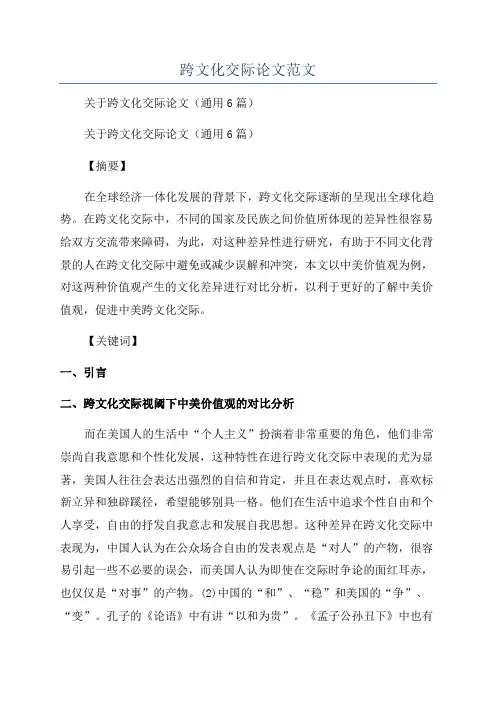
跨文化交际论文范文关于跨文化交际论文(通用6篇)关于跨文化交际论文(通用6篇)【摘要】在全球经济一体化发展的背景下,跨文化交际逐渐的呈现出全球化趋势。
在跨文化交际中,不同的国家及民族之间价值所体现的差异性很容易给双方交流带来障碍,为此,对这种差异性进行研究,有助于不同文化背景的人在跨文化交际中避免或减少误解和冲突,本文以中美价值观为例,对这两种价值观产生的文化差异进行对比分析,以利于更好的了解中美价值观,促进中美跨文化交际。
【关键词】一、引言二、跨文化交际视阈下中美价值观的对比分析而在美国人的生活中“个人主义”扮演着非常重要的角色,他们非常崇尚自我意愿和个性化发展,这种特性在进行跨文化交际中表现的尤为显著,美国人往往会表达出强烈的自信和肯定,并且在表达观点时,喜欢标新立异和独辟蹊径,希望能够别具一格。
他们在生活中追求个性自由和个人享受,自由的抒发自我意志和发展自我思想。
这种差异在跨文化交际中表现为,中国人认为在公众场合自由的发表观点是“对人”的产物,很容易引起一些不必要的误会,而美国人认为即使在交际时争论的面红耳赤,也仅仅是“对事”的产物。
(2)中国的“和”、“稳”和美国的“争”、“变”。
孔子的《论语》中有讲“以和为贵”。
《孟子公孙丑下》中也有说到“天时不如地利,地利不如人和”。
由于受到这些传统思想的影响,中国人自古以来就非常崇尚“万事和为贵”,在交际中往往给人一种和睦和气、谦恭温顺的形象,同时,在“知足常乐”思想的影响下,中国人即使在遭遇困境时也能苦中作乐和泰然处之,由此可见,这种安于现状的思想让中国人缺乏了主动竞争的意识,表现在行为上比较保守,不愿冒险和拼搏,比较喜欢从事稳定的职业,容易产生满足的心理。
相比之下,仅有两百多年历史的美国却已然成为世界超级大国,美国人勇敢、爱好自由并且重视竞争,他们很难满足于现状,希望能够通过不断的奋斗和尝试来获取更大的发展和达到更高的目标。
这种积极的心态和强烈的竞争意识与中国人知足常乐和安于现状的思想有着显著的差异。
跨文化交际毕业论文摘要:如今,跨文化交往的频率在不断增加,而数量上的增加并不意味着质量上的改善。
这样的交往常常会加深已有的既定模式、偏见和自我文化意识。
关键词:外国文学;跨文化交际最早使用“东方”与“西方”称谓的是古代闪米特人。
他们生活在亚洲西部,是今天以色列民族和巴勒斯坦民族的共同祖先。
最早的东西方划分依据就是日出东方,日落西方。
在今天看来,东方和西方的划分,在政治、经济、制图学和文化学都是不同的。
如果我们按人类文化学的一般划分,将基督教文化、伊斯兰教文化、佛教文化、儒教文化和黑非洲文化称为世界五大文化区的话,则除基督教文化区属于“西方”之外,其余都属于“东方”。
事实上,东西方文化的交流与冲突不仅历史悠久,其内部大都存在自身文化的多元和丰富,他们之间的交流与互动更是此起彼伏、重叠交叉。
1跨文化交际的含义跨文化交际Cross-CulturalCommunication/InterculturalCommunication是国际交往日益频繁背景下一门新兴学科,在中文中亦可译为“跨文化传播”“、跨文化交流”等。
“它指本族语者与非本族语者之间的交际,也指任何在语言和文化背景方面有差异的人们之间的交际。
跨文化交际研究产生于20世纪50年代,是一门综合性学科,它是当代社会科学学科综合研究的结果,学科背景主要涉及文化语言学、社会语言学、言语交际学。
”[1]目前跨文化交际的研究主要集中在外语教学界。
2跨文化交际的主要障碍德国学者马勒茨克提出:跨文化交际的主要准备是了解不同文化的感知方式、时空观、思维方式、语言特征、价值观、行为模式、社会规范和物质文化差异等,而人们都认为跨文化交际的主要障碍则是一些“定型观念”和主观偏见。
定型观念和偏见都是相当普遍的社会现象。
多数定型观念中有符合事实的部分,也有不符合的部分,不符合事实的部分就可以说是“偏见”。
“歧视”是偏见的行为倾向,包括群体歧视、文化歧视、民族歧视和种族歧视。
Barriers Caused by Stereotypes to Intercultural Communication:A Case Study of Green Book刻板印象对跨文化交际造成的障碍一以《绿皮书》为例Barriers Caused by Stereotypes to InterculturalCommunication:A Case Study of Green Book刻板印象对跨文化交际造成的障碍一以《绿皮书》为例AbstractDifferent countries and races in the world have different historical backgrounds and cultural differences, and our thoughts and behaviors will be influenced by our cultural backgrounds, and then some stereotypes will be generated.Taking the film Green Book as an example, through the analysis, from the perspective of the two protagonists changing their views imperceptibly, this paper analyzes the stereotype between different races and its reasons. This paper mainly focuses on the analysis of racial discrimination, and find its solutions.Key Words:stereotype;cultural barriers;Green Book摘要世界各国与各种族之间都存在着不同的历史背景及文化差异,我们每个人的思想和行为会因为受到所处文化背景的影响,继而产生一些刻板印象。
文化英语论文题目选择参考英语文化是跨文化交际中的研究重点,英语作为世界上通用语言,其拥有悠久的历史文化,对英语文化的研究有助于我们对英语的学习,下面列举了125个文化英语论文题目供参考。
1、英语专业学生跨文化交际能力调查研究2、跨文化交际能力在英语阅读教学中的培养策略分析3、大学生跨文化交际能力的培养--从英语原版电影的角度分析4、多元文化背景下大学公共英语教学中的跨文化意识培养探析5、浅谈饭店英语文化教学的问题和对策6、中国传统文化在大学英语教学中的导入研究7、论文化导入与大学英语教学8、多媒体英语教学中的文化教育9、文化语境在大学英语翻译教学中的制约作用10、论英语文学的文化疆界及形象阐释11、中学英语教学中“跨文化意识”的缺失及对策12、艺术院校跨文化任务型大学英语教学模式理论、实证研究13、在英语教学中渗透文化教育浅析14、浅谈中学英语课堂中的母语文化教学15、文化移情视域下的高校英语教学研究16、英语翻译中中西文化差异的影响分析17、论中国文化教育融入英语课堂的必要性和可能性18、跨文化交际与高校英语教学初探19、高职英语词汇教学中表层文化迁移现象及其应对策略20、跨文化交际视角下高中英语课外活动的构建21、英语阅读教学中的文化渗透22、浅谈高中英语中对词语文化背景的教学23、论中华传统文化在英语教学中的融入24、初中英语课堂中学生跨文化意识的培养25、非英语专业大学生跨文化交际中语用失误的实证研究26、新闻英语翻译与跨文化意识解析27、隐性大学英语课程的开发对高校校园文化建设的推动28、大学英语学习者本土文化认同现状的调查研究29、跨境电商背景下高职商务英语教学中的文化渗透30、大学英语课堂中的中华传统文化价值教育31、大学英语教学中计算机主导的跨文化能力培养研究32、文学生态学视角下英语教育中的中国文化失语现象33、非英语专业大学生跨文化交际能力的对比研究34、大学英语课堂教学文化教育导入研究35、论大学英语教学中的中国文化36、浅谈跨文化视域下艺术学生英语语言能力的培养37、跨文化视角下英语教学中母语文化缺失问题探究38、社会文化视角下英语专业写作教学的多角色参与模式39、英语在提升城市文化软实力中的媒介作用研究40、基于文化意识培养视域下的英语教学研究与反思41、商务英语教学中跨文化幽默的实现--基于翻转课堂下混合学习模式42、论中西方茶文化差异和英语教学手法差异的内在关系43、文化学视阈下英语文学作品的翻译技巧研究44、视觉文化语境下大学英语口语能力培养研究45、探析我国高校英语教育中中国文化失语现象及应对措施46、交互式文化教学对英语学习影响的个案研究47、文化导入对高职英语教学的重要性探究48、论英语习语的文化特征及翻译49、英语教材中编排母语文化的合理性分析50、从中西茶文化的差异体验大学英语文化教学51、基于茶文化角度的大学英语文化教学探究52、从文化的角度讨论中国菜的英语翻译53、少数民族学生英语习得的文化障碍及对策54、中西文化差异下英语翻译教学的实施途径55、文化资本视角下学生英语文化认同能力的缺失与重构56、高校英语文化教学及其变量研究57、跨文化意识培养在高职英语教学中的作用58、“产出导向法”理念下中国文化英语体验式教学模式探析59、中国文化导入在大学英语课程中的教学探索60、浅谈三本院校英语专业精读课程对学生跨文化意识的培养61、从文化图式理论视角探析大学英语词汇教学62、大学英语教学中中国文化传播现状调查研究63、文化自觉时代高校英语教育中的中国文化素养64、英语教学中的茶文化现象65、从茶文化角度探究英语教学的模式构建66、中英茶文化差异与英语教学67、茶在英语语言与文化传播中的呈现与分析68、探析英语文学作品对英国茶文化的影响69、文化差异教育在英语教学中的重要性70、从中西茶文化的差异看大学英语教育71、关于大学英语教材中中国文化内容缺失的分析72、中学英语教学跨文化意识培养分析73、大学英语教学中文化的双向导入研究74、高校英语教学中文化负迁移现象及教学策略75、英语翻译实践中的文化欠缺和文化建构探讨76、文化体验视域下的大学英语词汇教学77、从美国通俗文化导入谈大学英语教学文化拓展78、通识教育视角下母语文化融入大学英语教学的意义和作用79、商务英语口语教学中跨文化非语言交际能力的培养80、信息化时代大学英语教学中中国文化输入的必要性及对策研究81、网络教学对英语校园文化建设的影响分析82、从文化角度看中西方英语翻译的差异83、英语与汉语语言文化的相互融合与渗透84、从语言和文化的关系看高职英语教学中文化因素85、浅议大学英语教学中学生跨文化交际能力的培养86、非英语专业大学生跨文化敏感度的调查研究87、论中西方文化差异与大学英语翻译教学88、少数民族学生英语教育优化的跨文化视角89、中国传统文化在高校英语教学的融入初探90、英语报刊选读教学对大学生跨文化意识的培养91、全球化语境下英语教学中文化教学的研究92、论高职院校英语课堂教学中的文化导入93、浅谈高中英语教学中实施跨文化教学的方法94、商务英语翻译的文化意向错位研究95、高校英语教学中如何培养学生的跨文化交际能力96、大学英语教学改革的文化哲学研究97、论英语新闻网站的受众文化心理对接98、论我国英语媒体跨文化传播能力建设99、英语报道中文化现象的多维探析100、英语教学中文化意识的培养101、大学英语教师的文化形象102、英语教学中语言文化渗透103、社会文化理论视角下的医护英语教学模式创新研究104、文化失语视域下互动式英语教学模式的实施105、大学英语课堂教学中英语文化塑造策略106、跨文化交际视角下的高职英语口语教学及其对策107、社会文化理论视阈下的多模态大学英语写作反馈体系的建构108、跨文化交际能力的形成在艺术类院校大学英语教学中的重要性109、巧用英语隐喻践行语言文化双向输入教学110、高职公共英语文化教学与跨文化敏感度发展研究111、浅析英语口译中的文化差异与应对112、浅析培养学前英语专业学生双语双文化的必要性113、大学英语教学中传统中国文化的传承与弘扬114、高职高专英语课堂教学中的中国文化缺失现象探析115、文化差异视角下的旅游英语翻译探究116、大学生用英语表述中国文化能力欠缺的原因分析117、论英美文化对学生英语跨文化交际能力培养的重要性118、浅谈新形势下大学英语教学改革中英美文化的融入119、论跨文化英语教学中学生民族文化自豪感的提升120、多元文化背景下民族预科学生英语习得研究121、英语习语与西方文化122、浅析英语教学中对大学生跨文化意识的培养123、英语教学中母语文化导入与批判性思维培养124、英语教学中的“文化平衡”125、国际视野下商务英语翻译的文化因素分析与策略英语具有较强的文化底蕴,在英语交际中,我们需要了解英语国家的文化,更好的融入到英语的国度,以上文化英语论文题目可以作为论文定题参考。
1. 英文原声电影赏析与跨文化交际能力的培养 2. 跨文化非语言交际语用失误研究 3. 公示语
翻译中的语用失误探析
4. 国内广告语言语用失误研究现状与分析 5. 全球化语境下跨文化交际失误语用归因 6. 跨文
化交际中的语用失误类型及对策研究 7. 基于礼貌原则的跨文化语用失误分析 8. 跨文化言语
交际中的语用负迁移 9. 浅析化妆品广告中的语用预设 10. 中西方饮食文化的比较研
究 11. 中美时间观之对比
12. 浅析汉英问候语中的文化差异 13. 英汉词汇的文化内涵差异探析 14. 英语身体语的交际
功能研究
15. 浅谈英汉身势语的表意功能之差异 16. 目标语文化的理解与跨文化交际
17. 中西文化差异对中国学生英语学生的影响 18. 跨文化交际中的文化误读
19. 浅析文化差异对商务谈判的影响 20. 英语禁忌语的文化内涵异同研究 21. 英语学习中的
文化习得
22. 英汉思维模式的差异对跨文化交际的影响 23. 外语学习者的思辨能力与跨文化交际之成
效 24. 培养英语学习者跨文化交际能力之策略 25. 英汉道歉语差异及原因 26. 中西跨文化礼
貌语差异探析 27. 英汉语言中礼貌表达法之比较 28. 英汉习惯用语的文化内涵探源 29. 英语
称赞语及其回应的异同研究
30. 中美(西)家庭教育理念的差异及其对孩子的影响 31. 中国英语学习者跨文化交际中的
主要障碍研究 32. 试析跨文化交际中角色互动的作用
33. 本土文化与异国文化的冲突对跨文化交际的影响 34. 跨文化交际中的时间观差异 35. 论
跨文化交际中的中西餐桌礼仪
36. 关于提升英语专业学生跨文化交际能力的培养 37. 涉外婚姻中的中西文化冲突
38. 论跨文化广告传播中食品商标的翻译
4
39. 多媒体教学与跨文化交际能力的培养 40. 中西方儿童文学的差异
41. 中西体育文化的差异及其受全球化发展的影响 42. 中西传统休闲文化及其价值观的对比
分析 43. 简爱与林黛玉不同命运的文化透析 44. 国际商务活动中礼貌原则的应用
45. 论文化背景知识在外语阅读教学中的作用 46. 国际商务交际活动中的非语言交际 47. 浅
析英汉汽车商标的特点及其翻译 48. 英汉隐喻差异的文化阐释 49. 文化语境下的英汉植物
词 50. 文化语境下的英汉动物词 51. 从体态语探析中西文化差异 52. 浅析英汉颜色词的文化
内涵 53. 文化视野下英语谚语的比较 54. 从广告语言特色看中西文化异同 55. 从数字喜好看
中西文化差异 56. 中西非语言行为的文化内涵探析
57. 从中英文动物比喻的不同看中西文化差异 58. 英汉概念隐喻的文化认知对比分析 59. 英
汉成语文化内涵比较研究 60. 从神话看中西文化异同
61. 文化视角下英汉时间隐喻比较研究 62. 英汉情感隐喻文化内涵对比研究 63. 从文化语境
看英汉爱情隐喻 64. 英汉动物隐喻的文化内涵
65. 论中英文中颜色隐喻的差异及其文化根源 66. 英汉习语中中西文化差异探源
67. 从英汉委婉语中看中西文化心理差异 68. 文化视阈中的汉英典故
69. 美国俚语的基本特征与社会功能 70. 从旅游广告看中西文化差异
71. 英语学习中中国文化缺失对跨文化交际能力的影响 72. 正视中西文化冲突提高跨文化交
际能力 73. 从跨文化交际中的语用负迁移反思英语教学 74. 情境教学法在跨文化交际教学中
的应用
75. 从跨文化交际的角度解读中西方礼貌准则和策略 76. 英汉委婉语及其在跨文化交际中的
作用 77. 跨文化中的归化和异化
78. 英语教学中学生跨文化交际能力的培养 79. 跨文化交际中的饮食文化差异
80. 从集体主义和个人主义看国际商务谈判的文化差异 81. 中英礼貌用语之差异
82. 过渡语僵化现象文化因素成因 83. 跨文化交际中的美国个人主义
5
84. 英汉隐喻的文化背景差异研究 85. 中英礼貌用语研究综述 86. 颜色词的文化内涵
87. 中国茶文化与西方咖啡文化对比研究 88. 汉英称谓语中的文化差异
89. 民俗风情游--中西“水”文化之比较 90. 跨文化商务谈判中的文化适应 91. 跨文化交际中
的空间观 92. 英汉习语的文化差异分析
93. 当代中美女性婚姻观的比较研究 94. 中美商务谈判礼仪之礼貌用语比较
95. 从《老友记》看现代英语词汇中的语言性别差异现象 96. 解析麦当劳文化在中国的流
行 97. 时间观差异在跨文化交际中的应用 98. 社会文化迁移对中国式英语的影响 99. 英语专
业学生跨文化交际能力模式研究 100. 跨文化交际中中美时间取向的差异分析 101. 中国与英
美国交际中的文化差异冲突案例研究 102. 从文化交际看动态对等翻译理论的指导性 103. 从
中西人格差异看大学生跨文化交际能力的培养 104. 文化认知理论观照下的民族差异与汉语
教育 105. 跨文化交际中的归化和异化翻译 106. 对大学新生公共英语教学的文化导
入 107. 跨文化交际中语篇信息度的等级及其等级调控策略 108. 大学校园文化中的非言语交
际形式剖析 109. 浅析汉英翻译中的文化因素 110. 浅谈跨文化交际中的文化多元化和文化冲
击 111. 文化认同协商视角下的奥巴马总统就职演说 112. 浅论文化习得与跨文化交际能力的
培养 113. 论文化意象与跨文化交际 114. 论文化图式跨文化交际与文化主体意识 115. 论文
化融合与跨文化交际中的语言翻译 116. 论文化间性翻译理念对文化交际与发展的意
义 117. 论文化和交际的多元性和能动性与跨文化交际学 118. 论文化负迁移与跨文化交际训
练 119. 论文化定势与跨文化交际中认知能力和移情能力的培养 120. 论文化定势及偏见在跨
文化非言语交际中的影响 121. 论文化定势对跨文化交际的影响 122. 论文化差异在跨文化交
际中的作用 123. 论文化差异对跨文化交际的影响 124. 跨文化交际论文写作对差生大学英语
学习影响的研究 125. 从中英问候习俗和见面礼节论文化差异对跨文化交际的影响 126. 中外
文化中恭维语语用差异与语用失误 127. 对外汉语教学中的语用能力培养 128. 试析中西习俗
文化“冲突
6
129. 文化差异与跨文化交际能力的培养 130. 汉语跨文化交际教学的思考 131. 试析跨文化交
际能力 132. 阅读理解中跨文化的意识 133. 跨文化交际中的饮食文化差异 134. 跨文化交际
中的服饰文化差异 135. 肢体语言在跨文化交际中的应用 136. 试论跨文化交际语用失误
137. 从色彩词汇看跨文化交际中的文化差异
138. 从“礼貌原则”看对外汉语教学中的跨文化交际 139. 试析跨文化交际中的非语言符
号 140. 跨文化视野下的汉语词汇教学
141. 跨文化视野下的汉语语用教学交际文化与跨文化语言交际 142. 对外汉语教学中的文
化教学原则 143. 对外汉语教学中的文化因素导入
144. 英语语言文化与汉语言文化之间对比分析(可选语音/词汇/语法/词汇/语用等某方面论
述) 145. 不同语言颜色词的文化意义差异 146. 试析跨文化交际能力的培养
147. 汉语第二语言教学中文化因素的导入 148. 汉英翻译与文化的关系 149. 中英思维方式的
比较 150. 汉英语言的对比